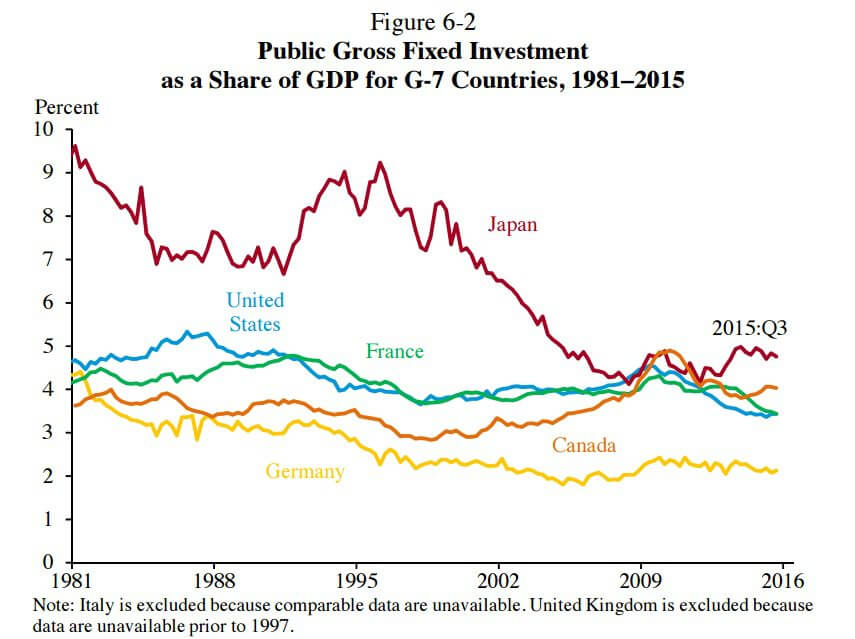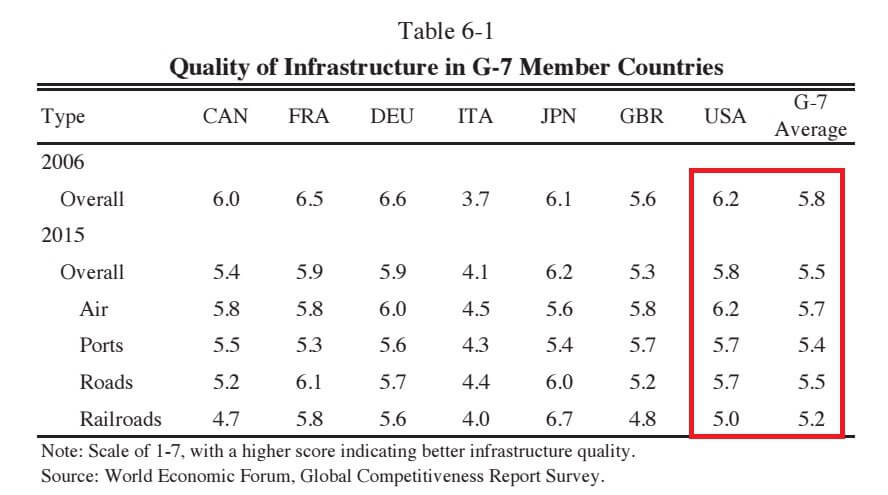Ricochet is the best place on the internet to discuss the issues of the day, either through commenting on posts or writing your own for our active and dynamic community in a fully moderated environment. In addition, the Ricochet Audio Network offers over 50 original podcasts with new episodes released every day.
 America’s Infrastructure via Charts
America’s Infrastructure via Charts
Given low interest rates and the need, I can certainly understand the case for a boost in public infrastructure spending. But as these White House charts show, talk of an infrastructure “crisis” seems overblown:


 And some good words on this from Timothy Taylor:
And some good words on this from Timothy Taylor:
Published in EconomicsThe concept what infrastructure is important for the 21st century needs to be much broader than roads and bridges, and even broader than transportation. It needs to include investments in energy infrastructure, which includes oil and gas pipelines and the electrical grid — and in particular, expanding the capabilities of the electrical grid so that it can more easily incorporate intermittent but renewable energy sources like solar and wind, and also so that it can be used for variable pricing to encourage conservation. Infrastructure also needs to include the communications infrastructure. Both energy and communications systems also need updating to reduce their vulnerabilities to hacking and to damage from natural disasters or terrorist attacks. …
A policy agenda for updating the communications and energy infrastructure is more difficult, because it involves thinking about infrastructure that is owned by private companies and because it opens up broader questions, like choices about energy policy choices and the security of communications. I’m fine with also updating and maintaining roads and bridges. But those kinds of road-based infrastructure investments aren’t likely to be main drivers of 21st century American economic growth.




And, of course, you can’t do anything regarding infrastructure that has not already gone through NEPA, and 15 other reviews, etc. Remember Obama touting “shove-ready” projects, and it turned out that due to regulation, there weren’t any?
The problem with the constant talk about infrastructure investment is that Democrats and too many Republicans want to use it as “stimulus” when aggregates are soft. If the return to an infrastructure investment is solid, if it’s needed, it should be built in some order of priority. Cut spending on welfare, subsidies, pork, crony deals, foreign aid, useless education and energy bureaucrats, go for it. But that isn’t what happens. These hucksters want to use aggregate data to justify pork called infrastructure during an “economic emergency”, get the bucks out to shovel ready projects as quickly as possible before anyone figures out it’s just pork and payoff, not real priority infrastructure investment with a high return. It’s disgusting, but then what’s new.
This. Infrastructure rewards investment where there’s a need not being meet. If the ‘need’ is political payoff, the chances of it aligning with an actual benefit are poor.
It also has the problems of all Keynesian ‘investment’: Assuming that people are too stupid to figure out that the temporary cash flow is just that, and that it comes with long term costs (debt, taxation, diversion from productive investment). When the stimulus payoffs are flowing, the prudent shut their wallets.
Just examine the ‘Japan’ line in the OP chart. That’s Japan trying to float its economy on the back of ‘infrastructure’ projects,. It didn’t work and has left the country with the developed world’s highest debt to GDP.
Where are the China statistics? A reason they are left out?
Quality of railroads in France and Germany is better than in the United States? This assertion says to me that either they are skewing the metric to emphasize passenger rail and de-emphasize freight rail, or that they don’t understand this transportation mode very well at all.
There is a lot of freight going by road in Europe that would go by rail in the US.
I’d guess there’s a big difference in spending money on maintaining/improving infrastructure versus building out entirely new infrastructure. We and the countries we’re comparing against are doing the former; China’s doing the latter.
This is not a surprise. The “infrastructure crisis” has been mostly egged on by leftists that want bigger government and higher taxes on the rich…the infrastructure part is mostly incidental. Second, the the group cited most frequently lamenting the poor state of our infrastructure is…wait for it…wait for it…the American Society of Civil Engineers. Geez, shocked that they thnk we need more investment…they always think that. When you are a hammer, everything looks like a nail.
Here in Pennsylvania, we do have a dire situation. The first part is that our bridges, roads and locks/dams are at various stages of failure. The second part is that for decades, money needed to maintain that infrastructure has largely gone to create new, largely unneeded infrastructure and to line organized labor’s pockets with dough (so they could pay Democrats to create more unneeded infrastructure).
Yes, they want higher taxes on the rich, but they also want favorable tax treatment for the rich so they can escape those taxes if they buy debt are properly obliged to the ruling class. Alexander Hamilton tried to portray this sort of relationship of wealthy people to government debt as a good thing. If the main object is to have a stable government with the interests of the ruling class aligned with wealth, I suppose it is. When our country was getting started, it was probably a good and necessary thing. Now we’re seeing the unsavory side to it.
Well, yeah, the ASCE does do some spin-doctoring, but they have a really good case. I see this from the design side. Several of the states are deferring maintenance in order to have a small amount of funds to build some new projects. I agree that some of the new projects are not well-conceived, but most of them are. As transportation funds shrink, the ability to fund fluff projects declines, and the ones that do get funded are badly needed.
Out of all the functions of government, transportation is the only function I know that has been experiencing real cuts.
Hey, I am curious. Do we have a railroad bubba on Ricochet? I am guessing that the condition of American railroads have improved a lot for two reasons. One is upgrades to signaling systems, which, while really good, does not represent much actual spending in the context of national infrastructure. Two, the railroads abandoned a number of spur tracks and some short lines, so there are less RR miles in the system and the overall condition ratings improved.
Is there a member who can speak to that?